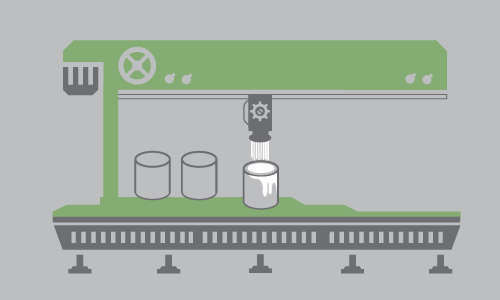Almost all major industrial processes generate significant amounts of air pollution that need to be treated before they enter the atmosphere. Like many other industries, paint manufacturers have to abide by regulations set by the EPA that limit the amount of untreated pollution these factories can release into the air.
Paint factory managers are always looking for a cost-effective solution that helps them control their factory’s VOC emissions and abide by these regulations.
VOC abatement systems provide a viable alternative to destroy air pollutants in paint manufacturing facilities at a low cost. That being said, there are different abatement technologies available and choosing the best system for your operation may become a daunting task.
Pollution Control and the Paint Manufacturing Industry
Paint manufacturing has existed in some form or another for nearly 300 years, but around World War II, the processes have changed to incorporate new solvents and resins. This unfortunately created new forms of pollution, and throughout the second half of the 20th Century the government began to crack down on all manufacturers known as polluters, putting a special focus on paint and coatings manufacturing.
It’s estimated that paint manufacturing facilities release anywhere between 10 and 25 tons of air toxins into the atmosphere every year. In fact, the problem is so big that the EPA has created a list of unique requirements that apply to this industrial process and all of its sub-branches.
This is one of the reasons why the required VOC destruction rates are as high as 98% for each factory, which means these facilities need to employ state-of-the-art equipment that allow them to meet that goal.
How to Choose the Best VOC Abatement System for a Paint Factory
VOC abatement mechanisms vary in size, basic design, and destruction method. Not only this, factory managers need to choose a system that is capable of destroying paint-derived VOCs while contributing to the plant’s overall efficiency.
When choosing any major piece of equipment for your facility, there are many factors you should look at, and in order to choose the best abatement system, you need to look at:
Destruction Rates
VOC destruction rate requirements can vary for paint manufacturing facilities but are almost always higher than 98%, so you need to implement a solution that meets or surpasses those efficiency demands.
Energy Efficiency and Operating Cost
Implementing a VOC abatement mechanism represents a huge addition, so you need to select an energy efficient model that is not expensive to run. Some modern systems even feature heat recovery features that help reduce cost while still allowing you to meet EPA-set regulations.
System Footprint and Integration
Always consider the space you have available before choosing an air pollution control system. The size and shape of the new machinery should fit comfortably in your facilities, and it should be easy to integrate with the rest of your operations.
Overall Investment and Future Capacity
While many VOC abatement systems offer energy-recovery features, they may require a significant initial investment. That being said, if you design and size your system with future capacity in mind, installing the correct abatement equipment can help improve your facility’s overall performance / compliance for years to come.
Technical Complexity and Volume Requirements
Most VOC abatement mechanisms are extremely reliable. However, you need to consider the technical complexity and look at the minimum and maximum volume requirements for your specific system to make sure it operates efficiently.
Regenerative Thermal Oxidizers: A Reliable Solution for Paint Manufacturers
Regenerative thermal oxidizers, also known as RTOs, provide a superb solution for paint manufacturing facilities. With VOC destruction rates as high as 99%, this system relies on high temperatures to break down pollutants into water, heat, and CO2.
In addition to the above, RTOs employ heat exchange mechanisms to reduce operating cost, making them extremely energy efficient.
Finally, custom regenerative thermal oxidizers can be designed to fit an array of factory layouts and are suitable for low air pollutant concentration, making them ideal for paint manufacturers.
Rotary Concentrator
Many facilities may benefit from the use of a rotary concentrator system, a solution designed to help manufacturers with high-volume, low-concentration emissions to operate more efficiently. For facilities in the paint and coatings industry, the rotary concentrator is an ideal option.
The rotary concentrator employs a concentrator wheel consisting of a hydrophobic Zeolite media in which the pollutants are passed through the concentrator and complete an adsorption/desorption process before the concentrated emissions are passed to an RTO for destruction.
This equipment benefits facilities as it can significantly reduce the size of the RTO being used to destroy a pollutant, in turn decreasing operating costs and resulting in better reliability.
Note on Rotary Concentrators: Filtering is a Necessity
While the Rotary Concentrator/RTO combination is the most effective way to provide savings and destruction efficiency for paint manufacturers, any dust or particulate must be filtered out of the emissions before reaching the concentrator, as this particulate can clog and destroy the wheel, rendering the system ineffective and out of regulatory compliance. This issue will be discussed with your VOC abatement specialist.
Get a Custom RTO Today
Custom VOC abatement solutions can help you abide by environmental regulations, but you need to choose a reliable manufacturer. At The CMM Group, we specialize in manufacturing custom RTOs as well as alternative systems designed to control VOCs and other pollutants.
Get in touch with us by giving us a call or by filling out our online contact form and our team of specialists will be more than happy to help you. Contact us today!
Sources:
- https://www.epa.gov/stationary-sources-air-pollution/paints-and-allied-products-manufacturing-national-emission
- https://www.epa.gov/stationary-sources-air-pollution/fact-sheet-final-rule-reduce-air-toxics-emissions-area-source-0




